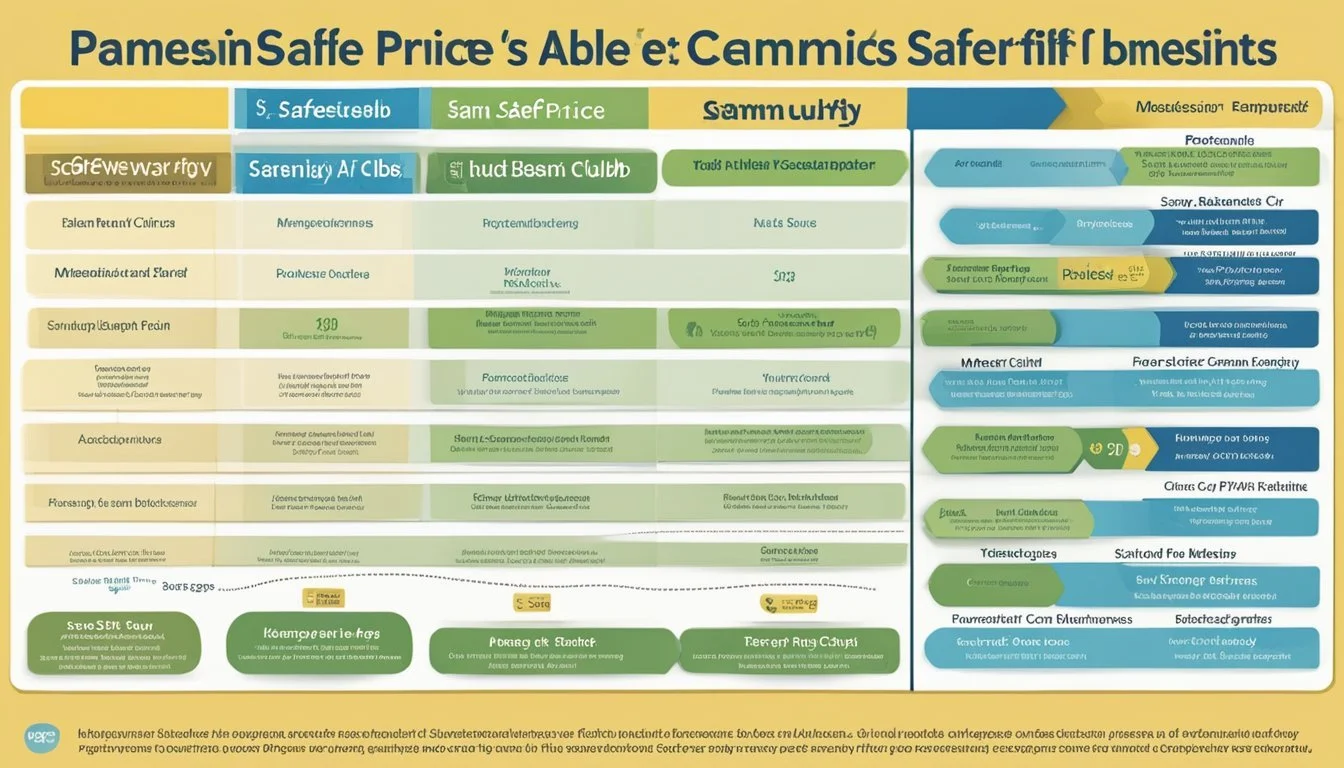Is Safeway Cheaper Than Sam's Club?
Comparing Grocery Shopping Costs
Part of Our Grocery Store Guide with Details on Safeway Prices and Sam's Club Prices
Determining whether Safeway or Sam's Club offers better value often hinges on the specific needs and shopping habits of consumers. Sam's Club, a membership-based warehouse providing bulk goods often at discounted rates, is tailored to those looking to stock up on large quantities. In contrast, Safeway operates as a traditional grocery store featuring a wide range of products with regular promotions and discounts.
Price comparisons between Safeway and Sam's Club have shown that both establishments offer competitive rates, each scoring an overall rating of 4.4 on Knoji, a popular consumer insight platform. Yet, the individual shopper's value perception may vary based on brand preference, product quality, and quantity needed. For some, the bulk savings at Sam's Club may outweigh Safeway's convenience and frequent sales, while others might prefer Safeway's specialty items and smaller package sizes that suit a more typical household's consumption.
Comparing Retail Models
When assessing the value proposition of Safeway compared to Sam's Club, one must consider the fundamental differences in their retail models. This section explores the contrast between warehouse clubs and traditional supermarkets, alongside the various membership formats they offer.
Warehouse Clubs vs Supermarkets
Warehouse stores like Sam's Club operate on a bulk-sale basis, providing a wide range of products from groceries to electronics in large quantities. The parent company, Walmart, allows Sam's Club to leverage significant buying power, which often results in lower prices for the consumer. Supermarkets such as Safeway focus on a traditional retail approach, offering a diverse array of goods at standard retail sizes and prices. The shopping experience at supermarkets is tailored to everyday needs and often includes a larger selection of specialty items that may not be available in warehouse stores.
Membership Fees and Structure
At Sam's Club, individuals must purchase a membership to access the store's discounted pricing. The basic membership fee is typically around $45 per year. A Plus Membership might also be available, offering additional benefits like cashback rewards and free shipping for an increased fee. On the other hand, supermarkets like Safeway do not require a membership; they are open to the general public without an upfront fee. Membership structures at warehouse clubs provide exclusive access to deals which can lead to savings over time, provided the member shops frequently enough to offset the initial cost of membership.
Price Analysis
In assessing whether Safeway is cheaper than Sam's Club, one must consider various factors, including individual item costs, bulk purchase benefits, and potential savings from discounts and deals.
Item by Item Comparison
When analyzing prices for commonly purchased grocery items, shoppers often find that unit prices tend to be a deciding factor. A direct comparison of individual commodities such as bread, milk, and eggs shows variation depending on the store and geographic location. For example, Sam's Club, which operates on a membership model, may offer lower unit prices on these items when compared to Safeway, particularly when purchased in larger quantities.
Bread: Sam's Club may offer a pack of two loaves at a price point that Safeway matches for a single loaf.
Milk: Pricing for a gallon of milk can be compared, with Sam's Club often exhibiting lower prices due to bulk packaging.
Eggs: A crate of eggs at Sam's Club, purchased in bulk, can be more cost-effective than buying smaller quantities at Safeway.
Bulk Purchase Considerations
Customers must evaluate the benefits of bulk purchases, which is a hallmark of shopping at Sam's Club. The cost per unit tends to decrease with the increase in quantity, making Sam's Club an attractive option for those able to store and consume products before they expire. Conversely, Safeway offers items in smaller quantities, which might have higher unit prices but could reduce waste for smaller households.
Bulk Advantage: A comparison of bulk rice or canned goods could show significant savings at Sam's Club.
Storage and Consumption: Shoppers need to consider their capacity to store bulk items and the rate of consumption to avoid potential waste.
Additional Discounts and Deals
Both retailers offer various discounts and deals that can affect the overall cost. Sam's Club might provide savings through in-store promotions for its members, while Safeway has a range of coupons and weekly deals accessible through its Just for U program.
Sam's Club Discounts: Members may receive instant savings applied directly to their purchases.
Safeway Deals: Customers can use Safeway's app to access digital coupons and personalized deals that can lead to substantial savings on their shopping bills.
Product Selection and Quality
When evaluating product selection and quality at Safeway and Sam's Club, customers will notice distinct differences in the variety of products, the freshness of groceries, and the value offered by private label brands.
Food and Groceries
Safeway is known for providing a broad range of food items and groceries, including a strong emphasis on fresh produce and organic options. Their stores often cater to health-conscious consumers looking for specialty food products.
Sam's Club, with its affiliation with Walmart, boasts an extensive selection as well, but with a focus on bulk items and larger quantities. They are recognized for offering value in basics such as potatoes and lettuce but might lack some of the niche products found at Safeway.
Non-Food Items
In terms of non-food items, Sam's Club typically offers a wider range of products due to its warehouse club model. Customers can find electronics, clothing, and home goods in addition to their grocery shopping.
Safeway, while primarily a grocery store, also stocks a variety of everyday household items, though not as extensively as Sam's Club.
Private Label Brands
Both retailers offer competitive private label brands that appeal to bargain-seekers. Safeway's store brand is known for providing quality at a reasonable price.
Sam's Club's Great Value brand, associated with Walmart, is designed to compete with national brands on both price and quality, offering everything from food staples to non-perishable goods.
Kirkland, Costco's private label, is noteworthy for its quality, but as it is not associated with Safeway or Sam's Club, it is not a direct part of this comparison.
Membership Benefits and Services
When comparing Safeway and Sam's Club, consumers should consider the range of membership benefits and services each retailer offers. Specifically, Sam's Club provides a tiered membership system that includes rewards, cash-back options, and an array of services designed to enhance the shopping experience.
Rewards and Cash Back
Sam's Club members can access various rewards and cash-back benefits. This system incentivizes shoppers to make regular purchases. Sam's Plus members, for instance, are eligible for cash rewards where they can earn $10 for every $500 spent. Additionally, members can capitalize on members-only fuel savings, where they could save an average of 7-10% at the pump.
Additional Membership Services
Under the umbrella of services, Sam's Club extends several membership services that improve convenience and value. Free shipping is available for Plus members on most items sold online, which provides significant savings over time. The Scan & Go feature allows members to check out faster by scanning items with their smartphone as they shop, bypassing traditional checkout lines. Furthermore, access to a pharmacy with exclusive savings on medications can be a game-changer for some families. These services are distinct from typical grocery retailers like Safeway and are integral to a Sam's Club membership.
Shopping Experience
When comparing the shopping experiences at Safeway and Sam's Club, customers should consider the in-store ambience, online shopping features, and ease of access to services like curbside pickup or delivery.
In-Store Shopping
At Sam's Club, the in-store experience is tailored to a bulk-shopping audience. Customers can expect to navigate large warehouse-like spaces with a focus on volume savings—appropriate for those shopping for large families or businesses. Services like curbside pickup and a self-service checkout can enhance the shopping experience. In contrast, Safeway provides a more conventional supermarket environment. It offers a broader variety of brands and smaller package sizes, which cater to everyday consumer needs.
Online Shopping and Mobile Apps
Safeway has leveraged digital platforms, with a strong online presence and a user-friendly mobile app, facilitating features like online shopping and home delivery services. Customers can also easily access discounts and coupons digitally. On the other hand, Sam's Club competes favorably with its online shopping options, where customers enjoy the convenience of buying in larger quantities with competitive prices. They too offer a mobile app which includes Scan & Go feature, allowing customers to scan items and check out with their phones in-store.
Convenience and Accessibility
Sam’s Club, being part of the Walmart family, tends to have wider geographical coverage in comparison to Safeway. This can make a difference for members who travel or live outside of major urban centers. Both retailers offer delivery options, with Safeway typically focusing on its immediate geographic markets. Sam’s Club may provide an advantage for those seeking bulk purchases delivered to their doorsteps, potentially partnering with platforms like Amazon for certain logistic operations. Target shoppers looking for an experience between warehouse and traditional grocery stores might find Safeway's format more accessible for their shopping preferences.
Budget and Savings Considerations
When comparing Safeway and Sam's Club, customers need to evaluate the budget impact and potential savings. The actual cost benefits can vary based on shopping habits, the value of bulk purchases, and annual membership fees.
Calculating Overall Savings
Safeway offers a competitive selection of groceries that appeals to customers who prefer a traditional supermarket experience. On the other hand, Sam's Club operates on a membership model, charging an annual fee of $45 for basic access which includes warehouse entry and additional services like gas stations and free curbside pickup. Sam's Club may present lower per-item costs due to bulk buying options, which can result in significant savings for frequent and bulk buyers. Customers should assess their annual spending to determine if the savings at Sam's Club offset the membership fee.
Shopping List Strategies
To optimize savings, shoppers should construct a strategic shopping list. At Sam's Club, larger quantities offer lower unit prices, but consumers must ensure they can consume the bulk products before expiry to avoid waste. In contrast, Safeway does not require bulk purchases, which can be beneficial for smaller households or those looking for specific brands and products not available in bulk.
Sam's Club: Best for bulk staple items and non-perishable goods.
Safeway: Ideal for brand-specific purchases and smaller quantities.
Impact of Membership on Budget
The impact of Sam's Club's membership on a shopper's budget depends on their frequency of visits and the volume of goods they purchase. While Safeway does not require a membership, it may not offer the same level of bulk discounts. Households should compare their typical grocery expenses against the potential savings from a warehouse club membership to make an informed decision.
Annual Membership Fee: $45 at Sam's Club; not applicable at Safeway.
Potential Bulk Savings: Higher at Sam's Club if the bulk purchase fits the customer's consumption patterns.
By carefully examining these factors, customers can determine which retailer offers the better savings for their specific shopping and budget needs.
Store Brands and Exclusives
When comparing shopping options at Safeway and Sam's Club, store brands and product exclusivity play crucial roles in determining value and cost-effectiveness.
Comparing Store Brand Products
Safeway's store brand — often considered equivalent to national brands in quality — competes well on price within the market. For example, Safeway's Signature Select offers competitive pricing, typically positioned to be more cost-effective than national branded counterparts. On the other hand, Sam's Club, with its Member's Mark brand, often presents products in bulk format, providing sizable savings for its members over time.
Example Store Brand Comparisons:
Safeway: Signature Select
Sam's Club: Member's Mark
Exclusivity and Product Availability
Both retailers present unique items not available at competing stores. Sam's Club, a members-only warehouse, often stocks items in larger quantities, providing exclusive deals on bulk purchases. Safeway, while open to the general public without a membership, also boasts exclusives especially within its organic and specialty ranges, catering to customers looking for specific product lines. Other competitors like Trader Joe’s and Aldi similarly offer exclusive in-house labels, such as Trader Joe's private label items that prioritize unique flavors and Aldi's Simply Nature for organic options.
Store Brand Exclusivity:
Safeway: Organic and specialty items.
Sam's Club: Bulk product deals.
Trader Joe's: Unique flavor profiles.
Aldi: Organic products with Simply Nature.
Geographical and Demographic Factors
When considering the cost differences between Safeway and Sam's Club, geographical location and demographic trends play significant roles in shaping pricing structures.
Location and Store Proximity
The proximity of Safeway and Sam's Club stores to the consumer's location significantly impacts cost. Sam's Club, a membership-based warehouse club, may not be as readily available in certain regions as Safeway, a traditional supermarket chain. As such, consumers might find Safeway more convenient but potentially more costly due to a lack of membership-based discounts that Sam's Club offers.
Safeway: Locations are widespread, and consumers often have easier access without a membership requirement.
Sam's Club: Fewer locations that require a paid membership, potentially offering lower prices due to bulk purchasing.
Local Store Variations
Prices and selection at local stores can vary based on the area's demographic and economic factors. A Safeway in a more affluent neighborhood might stock higher-end products with prices reflecting the local market's purchasing power. Conversely, Sam's Club might adjust its inventory and prices based on the local membership's demand and shopping patterns.
Safeway: Greater variation in pricing and product selection tailored to local demographic preferences.
Sam's Club: More uniform pricing due to bulk selling, but local demographic can still influence the availability of items.
Demographic factors such as average income, age distribution, and shopping behaviors of a region will influence the pricing dynamics of these stores. Consequently, Safeway may not inherently be cheaper or more expensive than Sam's Club; instead, the costs are reflective of location-specific elements and consumer demographics.
Potential Additional Costs
When comparing the costs of shopping at Safeway versus Sam's Club, one must consider not just the sticker price of items but also any potential additional costs. These might involve membership fees or money spent due to bulk purchases.
Hidden Fees and Expenses
Sam's Club requires customers to purchase a membership in order to shop, which can add a significant annual cost. For instance, their basic Club membership can cost $50 per year. Customers often overlook how these fees can add up over time, especially if they do not regularly take advantage of their membership benefits. It's essential to factor these costs into the total budget when determining whether Sam's Club provides a more cost-effective option than Safeway, which does not require a membership.
Cost-Benefit Analysis of Bulk Buying
While the notion of buying in bulk at Sam's Club may seem economical, it's important to consider whether these purchases translate to actual savings. Bulk buying can lead to:
Unplanned expenses: purchasing more than necessary due to the larger quantities.
Waste: if products expire before use.
When evaluating the value proposition of Sam's Club's bulk offerings against Safeway's regular-sized products, one must consider their household's consumption patterns and storage capacities. Only by doing so can they make an informed decision on where their money is best spent.
Industry Trends and Market Analysis
In the dynamic retail environment, the impact of inflation and evolving consumer behaviors significantly influence the pricing strategies of companies such as Safeway and Sam's Club.
Effect of Inflation on Prices
Inflation plays a critical role in determining the prices at retail outlets. As inflation increases, retailers like Safeway and Sam's Club may adjust their pricing structures to reflect higher operational costs. Sam's Club, being a wholesale retailer, often offers bulk items at lower unit prices, leveraging economies of scale. However, inflation can erode these price advantages over time. Safeway, primarily a traditional grocery store, may exhibit quicker price adjustments due to its smaller purchase volumes and the need to maintain profit margins.
Consumer Behavior and Retail Trends
Consumer behavior has seen a shift with an increased preference for value and convenience, particularly in technology integration for a seamless shopping experience. This has prompted companies to invest in online platforms and mobile technology.
Sam's Club: Continues to grow with plans for new, larger store openings, indicating a response to consumer demand for one-stop shopping experiences.
Safeway: Competes against brands like Costco and Walmart by offering brand variety and localized product selections that cater to specific customer preferences.
Both companies must navigate these retail trends, balancing technology integration with the in-store experience to remain competitive in the market.










